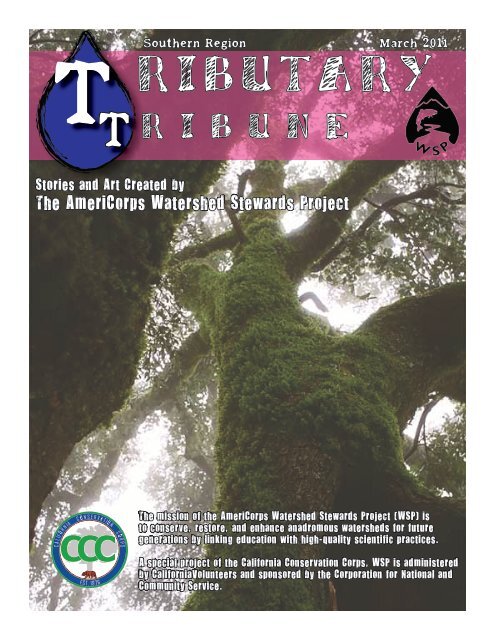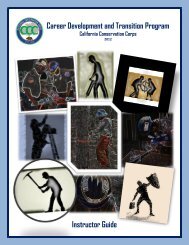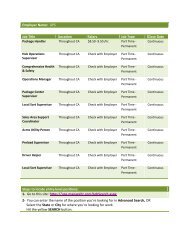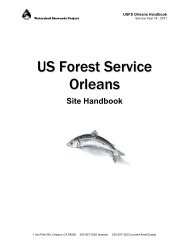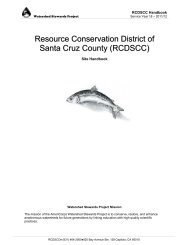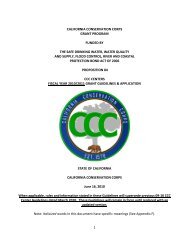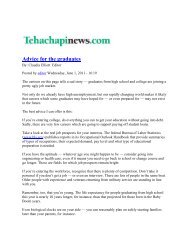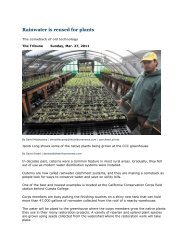Tributary Tribune - California Conservation Corps
Tributary Tribune - California Conservation Corps
Tributary Tribune - California Conservation Corps
Create successful ePaper yourself
Turn your PDF publications into a flip-book with our unique Google optimized e-Paper software.
Southern Region March 2011<br />
T<br />
r i b u t a r y<br />
T r i b u n e<br />
Stories and Art Created by<br />
The Ameri<strong>Corps</strong> Watershed Stewards Project<br />
The mission of the Ameri<strong>Corps</strong> Watershed Stewards Project (WSP) is<br />
to conserve, restore, and enhance anadromous watersheds for future<br />
generations by linking education with high-quality scientific practices.<br />
A special project of the <strong>California</strong> <strong>Conservation</strong> <strong>Corps</strong>, WSP is administered<br />
by <strong>California</strong>Volunteers and sponsored by the Corporation for National and<br />
Community Service.
TriButary <strong>Tribune</strong> 2011<br />
The <strong>Tributary</strong> <strong>Tribune</strong> showcases the adventures, insights,<br />
and art of members of the Ameri<strong>Corps</strong> Watershed<br />
Stewards Project. For seventeen years the WSP has been<br />
serving communities throughout <strong>California</strong>’s coast. This<br />
issue features stories and art by members from our<br />
Southern Region, placed in communities ranging from Fort<br />
Bragg to San Luis Obispo...<br />
Contents<br />
Charting the Waters p. 3<br />
One Watershed, One Community p. 6<br />
Reconciling the Past p. 8<br />
Wisdom in the Watershed p. 10<br />
Credits<br />
Stephanie Brindle - Editor<br />
Erika Stowe-Madison - Submission Supervisor<br />
Ryan Spencer - Layout Designer
<strong>Tributary</strong> <strong>Tribune</strong><br />
The<br />
Contributers<br />
WSP Members of the<br />
Southern Region<br />
Department of Fish and<br />
Game, Hopland<br />
Desiree Dela Vega<br />
Julie Hanson<br />
Redwood Science Lab<br />
Elizabeth McKinley<br />
Kimberly Campo-Allen<br />
Department of Fish and Game,<br />
Fort Bragg<br />
Katrina Nystrom<br />
Ben Schleifer<br />
Sonoma Ecology Center<br />
Daniel McKnight<br />
Summer Swallow<br />
Salmon Protection and<br />
Watershed Network<br />
Diana Baetscher<br />
Emilia Bauman<br />
San Mateo Resource<br />
<strong>Conservation</strong> District<br />
Alyssa Hernandez<br />
Farallones Marine<br />
Sanctuary Association<br />
Erica Warren<br />
Rietta Hohman<br />
Resource <strong>Conservation</strong> District of<br />
Santa Cruz County<br />
John Morley<br />
Nicolas Viveros<br />
San Luis Obispo County<br />
Steelhead Initiative<br />
Megan Dolson<br />
Wendy Laumer<br />
Aristotle Ou<br />
Southern Region, 2011<br />
2
Charting the Waters Into the Field, Into the Unknown<br />
Fantastic Voyage Under the Creek<br />
by Wendy Laumer<br />
On Thursday January 20th, I had an amazing opportunity to help<br />
with a snorkel survey for the Chorro Creek watershed.<br />
Chorro Creek is the main<br />
tributary for the Chorro Creek sub<br />
watershed and dumps sixty percent<br />
of the freshwater into the Morro<br />
Bay estuary. Morro Bay estuary is<br />
now a national reserve (circa.1995)<br />
and is monitored by The Morro Bay<br />
National Estuary Program.<br />
There are five tributaries to Chorro<br />
Creek which include Dairy Creek,<br />
Pennington Creek, San Luisito Creek,<br />
San Bernardo Creek, and Walters Creek.<br />
The portion of the snorkel survey<br />
that I had the amazing opportunity to<br />
experience took place on Dairy Creek; the<br />
other tributaries were surveyed earlier in<br />
the day.<br />
The survey area of Dairy Creek is accessible at Camp San Luis (CA<br />
National Guard) via Chorro Creek. My two partners in snorkel<br />
crime were Susan Kennedy and Jake Long, both Special <strong>Corps</strong><br />
Members for the Fishery Department at The Los Padres CCC<br />
Center. After making it through a Compressed Natural Gas fill up<br />
for the CNG van we were cruising (if you haven’t done this, it is a<br />
really interesting experience….the pump is pressurized making an<br />
awful sound when turned on and off and before fueling you must<br />
watch a safety video in order to even start the pump).<br />
The impetus for the survey was generated from an electro-fishing<br />
(E-fishing) grant which was approved by the Department of<br />
Fish and Game to remove an invasive species (the illustrious Pike<br />
Minnow). I was fortunate to have accompanied my two WSP team<br />
members Megan and Aristotle on an E-fishing expedition back in<br />
October with DFG on Chorro Creek. The snorkel survey was to<br />
complete the invasive species removal with a “fish eye” view for any<br />
remaining Pike Minnow that may have meandered up the tribs.<br />
The first part of the said snorkel survey mission included climbing<br />
into an amazingly fashionable poop green dry suit. Being a surfer<br />
for 20+ years, this was a far cry from the sleek super stretch wetsuit<br />
that I often refer to as my super suit. I will now refer to this suit as<br />
“the oompa loompa suit”. Oompa loompa suits are not complete<br />
without a dazzling pair of stream boots and strikingly<br />
large neoprene gloves. To make the ensemble really<br />
pop, a head squeezing hood along with snorkel and<br />
mask finish out the statement. Once I had “shrink<br />
wrapped” myself into the oompa loompa suit (this<br />
done by squatting down to remove any excess air<br />
and having a partner zip you in for a delightful,<br />
suction-like sensation), we were ready to traverse<br />
the incised bank to our journey under the stream.<br />
After a good wade through Chorro Creek,<br />
we found the confluence we were looking<br />
for. We lumbered up Dairy Creek looking<br />
like inebriated sailors until our promised<br />
bubble curtain was in full view. It was time<br />
to submerge. Crawling onto all fours, I then<br />
allowed my oompa loompa suit to do its<br />
magic. I spread my arms out very slowly and<br />
floated on top of the surface like a fallen leaf. Right in front of me,<br />
just below the bubble curtain, nestled slightly under a root wad,<br />
were two, eight inch rainbow trout enjoying the freshly oxygenated<br />
water of the small cascade. The newly discovered biosphere of<br />
the stream was a sight unlike any I’ve seen. I have snorkeled in<br />
Hawaii, Indonesia, Australia, and England, but this new “life<br />
aquatic” was surprisingly beautiful and serene. The colors abound<br />
were muted naturals including mossy and sage greens, beiges, and<br />
browns. The fish were silvery bright with fading parr marks. The<br />
water was clear, like being in a fresh water aquarium resplendent<br />
with bubbles.<br />
I floated transfixed on the trout watching, captivated by their every<br />
move. I wanted everyone to see and even stuck my hand out to<br />
alert Jake who was standing on the bank, my thoughts shouting<br />
“look”! Of course Jake could not see what I was viewing, but he<br />
already knew this world….<br />
Back on land, I climbed out of my oompa loompa suit and had a<br />
new admiration of its color. In the water I blended in so that the<br />
unsuspecting fish were no longer scared of my humanness. The<br />
air seemed a bit crisper, the light of the sun brighter. My day was<br />
transformed by the underwater world. I cannot wait to put my<br />
oompa loompa suit on again and venture back to the creek. Next<br />
time, though, I will remember to shower with Tecnu...<br />
POISON OAK!!!<br />
3 Southern Region, 2011
<strong>Tributary</strong> <strong>Tribune</strong><br />
Charting the Waters<br />
Nicolas Viveros at a site visit in the majestic<br />
Santa Cruz Redwoods. He is monitoring a<br />
post project aimed at reducing the amount of<br />
sediment entering the stream from rural roads,<br />
thereby protecting Steelhead habitat.<br />
Haikus<br />
By Ben Schleifer<br />
Salmon upon redd<br />
Glossy gaze meets surveyors’<br />
Each marks own meaning<br />
Floy tag in the spine<br />
Punch a star in operculum<br />
We count strong fish<br />
By Desiree Dela-Veg a<br />
Cold salmon buddy<br />
Allow me to join in play<br />
Your Stream calls to me<br />
Southern Region, 2011<br />
4
Charting the Waters<br />
Stream Boots are a Girl’s Best Friend<br />
by Alyssa Hernandez<br />
One December morning, my mentor, Marti, and I were<br />
prepping for our site’s Green Job <strong>Corps</strong> program. Green<br />
Job <strong>Corps</strong> is our environmental education program, and this<br />
month we were teaching at a boys detention center in the<br />
nearby area. This week was our benthic macroinverebrates<br />
lesson, and it was our big field day in the stream. The<br />
morning prep for that day was especially chaotic, but we<br />
eventually got all the supplies into the car and began our<br />
thirty minute drive to the center. It wasn’t until we had<br />
reached the site that I realized I had forgotten the most<br />
important tool for my lesson: my stream boots. For<br />
those of you who have never collected benthic<br />
macroinvertebrates, it requires you to hop in a<br />
stream and stand downstream with a special net<br />
and kick around the opening of the net to push<br />
insects into it. BOOTS ARE NECESSARY.<br />
How was I going to pull this off?<br />
We made our way to the<br />
stream with the boys and<br />
at this point I had<br />
a plan in mind. I<br />
couldn’t decide if my<br />
plan was exceedingly<br />
brilliant, or kind of<br />
dumb. It was probably<br />
the later, but I was going to<br />
go with it. Here was my logic. I was wearing Converse at<br />
the time, but was lucky enough to have a pair of hiking boots<br />
and a shirt in the back of my car. I decided I was going to<br />
take off my socks and wear only my Converse into the stream.<br />
The Converse would provide me with basic protection that I<br />
would need. The dry socks and hiking boots would be what I<br />
would wear once I was out of the water so my feet wouldn’t<br />
freeze off. Also, I had that shirt, which was going to be my<br />
makeshift towel for my feet when I took them out of my cold<br />
wet Converse. Sheer brilliance right? I thought so.<br />
Of course as my plan was put into action, there were<br />
definitely some flaws in my reasoning. Number one…<br />
Converse are made of cheap canvas material which provides<br />
no insulation whatsoever, so I might as well have gone in<br />
barefoot. Number two…it was December and we were in a<br />
mountain stream. The water was about 37 degrees F and that<br />
is not too far above freezing. I managed to get through my<br />
basic lesson without my feet falling off, but they did turn a<br />
lovely shade of cherry purple. It would also take the entire rest<br />
of the day for me to regain full feeling in my toes.<br />
I realize that these factors alone probably<br />
make this plan seem<br />
like a failure, but<br />
there are positives.<br />
These boys are at<br />
a detention center.<br />
That and the fact<br />
that they are teenage<br />
boys make it really<br />
hard to gain their<br />
honest respect and<br />
trust. It’s especially hard<br />
for me, seeing as how<br />
I am still very young, and<br />
my five foot three stature isn’t<br />
very authoritative. However,<br />
the moment I walked into that<br />
stream, you could hear their shocked<br />
reactions and see the looks of disbelief on their faces. I simply<br />
explained that sometimes science in painful, and you do what<br />
you need to do in order to get your data. After that, they<br />
remained completely engaged and were probably one of the<br />
most curious and respectful groups I have ever taught.<br />
Also, bugs are my passion. I really wanted to do this<br />
aquatic insects lesson. I had already showed them several<br />
pictures, but to have them see some of these insects up close<br />
was all I really wanted. In the end, it was completely worth it,<br />
even if my feet almost fell off in the process.<br />
<strong>Tributary</strong> <strong>Tribune</strong><br />
5 Southern Region, 2011
One Watershed,One Community<br />
(Above)<br />
John Morely and Nicolas Viveros lead a school group<br />
on the Soquel Creek Planting Day. Students learned<br />
about riparian corridors, salmon, and planted 20<br />
native species.<br />
(Below)<br />
Danny McKnight and Summer Swallow,<br />
WSP members placed with the Sonoma<br />
Ecology Center, lay the groundwork for<br />
a new native plant shade structure at the<br />
Sonoma Garden Park.<br />
Southern Region, 2011<br />
6
One Watershed, One Community<br />
The Ameri<strong>Corps</strong> Moment<br />
By Aristotle Ou<br />
- The Ameri<strong>Corps</strong> Pledge-<br />
I will get things done for America -<br />
to make our people safer,<br />
smarter, and healthier.<br />
I will bring Americans together<br />
to strengthen our communities.<br />
Faced with apathy,<br />
I will take action.<br />
Faced with conflict,<br />
I will seek common ground.<br />
Faced with adversity,<br />
I will persevere.<br />
I will carry this commitment<br />
with me this year and beyond.<br />
I am an Ameri<strong>Corps</strong> member,<br />
and I will get things done.<br />
<strong>Tributary</strong> <strong>Tribune</strong><br />
Megan, Wendy, and I were habitat typing one fine November day in Pennington Creek, home to the distinguished<br />
red-legged frogs and steelhead trout. Around four in the afternoon, we decided to wrap up the day and return to civilization.<br />
Unfortunately, the deeply entrenched Pennington Creek, filled with poison oak and lined with barbed wire, provided no easy<br />
outlets nearby for an exit.<br />
Megan, Wendy, and I travelled further upstream for about another hundred feet until we found what seemed to be an<br />
accessible route on the embankment. Megan attached the measuring tape to the side of her backpack and hung the loppers over<br />
her shoulders as she climbed across the embankment using the willows and coyote bush as stakes. When she climbed over 20 feet<br />
and reached the leveled surface, I elongated the stadia rod and passed it to her. Wendy, in her larger than life waders, clung to<br />
the clipboard filled with Pennington Creek habitat data we had worked so hard to collect as she climbed up using the shrubs and<br />
stadia rod Megan provided.<br />
As Wendy approached the last couple of feet of the embankment, her left foot suddenly slipped on the silty surface.<br />
Without hesitation, Megan reached out with her right hand to grab Wendy while still holding on to the stadia rod with her left<br />
arm. Megan pulled Wendy up, and due to Megan’s quick reflex, Wendy was saved. Meanwhile, I scouted the area with my<br />
monoscope and densiometer to watch for any predators such as mountain lions or turkey vultures. Finally, I climbed up and met<br />
with Megan and Wendy, who had despairing looks on their faces.<br />
In front of us laid a mini-forest engrossed in cape ivy. Megan, in frenzy, lifted the loppers off her shoulders and wildly<br />
hacked away the cape ivy. Wendy and I followed slowly behind, removing the shredded invasive species as Megan’s thunderous<br />
snips were tearing away the popular landscaping plants. After a few minutes of shearing, a ray of light shone through a small<br />
aperture. I rushed forward past Megan and widened the hole by tearing away the cape ivy with my bare hands.<br />
The sunlight blasted the expanded opening and lit up the dense mini-forest. My eyes filled with hope and tears as<br />
Megan, Wendy, and I walked back to our site vehicle. I experienced my Americorps moment that day, and I know many more<br />
will come my way.<br />
Faced with apathy, Megan took action against the cape ivy. Faced with conflict, Wendy found common ground with the<br />
leveled surface. Faced with adversity, I persevered until I saw the light. Megan, Wendy, and I are Americorps members, and we<br />
get things done.<br />
♫ “It doesn’t pay much, but it sure is fun. I’m an Ameri<strong>Corps</strong> member, and I get things done.” ♫<br />
7 Southern Region, 2011
Reconciling the Past, Redeeming a Species<br />
One Fish, Two Fish...<br />
by Katrina Nystrom<br />
One fish, two fish, red fish, blue fish or five Coho,<br />
three Steelhead, and one stinky carcass. That is what I<br />
am up to in Fort Bragg—counting fish. I would have<br />
never dreamt that that my job would include playing in<br />
creeks, hiking, exploring, and ultimately working to save<br />
endangered species.<br />
The other day my neighbor asked whether I was a<br />
fish biologist who did something with scales or a ‘fish<br />
counter.’ I found it quite enjoyable that he referred to my<br />
position the same way that my co-workers and I joke<br />
about. I told him that indeed I am counting fish, instead<br />
of the professional title of spawner surveyor or life cycle<br />
monitor. A former commercial fisherman himself, he<br />
was remarkably engaged in how the fish were doing.<br />
I told him that in Pudding Creek, they had counted<br />
120 Coho by the beginning of December (now the<br />
numbers are over 200). My neighbor even knew that<br />
was impressive compared to lasts years total of 10 and<br />
that Coho usually start heading up the creeks in this area<br />
around the end of December. The storms came early this<br />
year. It is nice to be in a community that cares about the<br />
fish count.<br />
Fort Bragg, located on the Northern<br />
<strong>California</strong> Coast, is an old fishing and<br />
logging town, but there are no more<br />
fish to catch or trees to cut. The history<br />
of logging in the area has altered the<br />
landscape. There are often old roads<br />
that run along the creeks that were built<br />
without an understanding of the local<br />
water systems, which leads to extra<br />
sediment in the creeks when the winter<br />
storms blow out the roads. Walking along<br />
the streams there are amazing trees that<br />
are 20ft in diameter, but only 20ft high.<br />
I haven’t yet seen a true old growth tree,<br />
but it seems like in most creeks the forest<br />
stands are starting to recover and provide<br />
more shade to keep the water cool.<br />
This has been an amazing record-breaking year.<br />
At the Van Arsdale Dam, the record of Chinook salmon<br />
climbing up the fish ladder almost doubled. In the<br />
1986/1987 season there were 1,754 Chinook; this year<br />
there were 2,315 which included 814 males, 746 jacks,<br />
and 755 female. A member from our crew measured the<br />
longest female at the dam, at 101 centimeters. The crew<br />
member was only 30 centimeters taller than the fish was<br />
long.<br />
I have been told by many of the old-timers in this<br />
once logging town that, historically, the numbers seen<br />
this year are not even comparable to the days of yore.<br />
These weather laden locals tell me that the original<br />
settlers to Northern <strong>California</strong> could not cross their<br />
horses when they came to the streams because the flows<br />
were packed bank to bank with fish. This is not the case<br />
now. That is why I am here.<br />
I hope to make the situation better—and it appears<br />
to be getting better. The data we collect helps with<br />
rehabilitation projects and setting state standards.<br />
Will salmon recover in Northern <strong>California</strong>? As<br />
the great Dr. Seuss once said, “Don’t ask us, go ask your<br />
mother.”<br />
Southern Region, 2011<br />
8
Reconciling the past<br />
Discovering the Natural<br />
By Diana Baetscher<br />
<strong>Tributary</strong> <strong>Tribune</strong><br />
“Choose one word to describe<br />
your experience.”<br />
“I learned a lot about<br />
restoration.”<br />
“One word?”<br />
“Oh, oops…”<br />
“Salmon.”<br />
“Fun.”<br />
“Interesting.”<br />
“Natural.”<br />
Natural? Did a field trip of<br />
eighth graders from San Francisco<br />
think of this as natural?<br />
Lagunitas Creek starts on Mt.<br />
Tamalpais and flows, momentarily<br />
unimpeded, to Kent Lake, where a<br />
small portion of its water is spit out<br />
beneath mammoth Peter’s Dam (A regulated minimum<br />
flow – to ensure salmon habitat is adequately managed).<br />
The stream bubbles beneath clunky log structures tied<br />
together with half-inch steel wire hoisted into the water by<br />
helicopter. It tumbles over multi-ton boulders with large<br />
metal grommets protruding from the<br />
cascade, where they too were hooked to<br />
a helicopter line.<br />
Lagunitas Creek slips underneath<br />
Shafter Bridge – under a road traveled<br />
by surfers and hikers enroute to Point<br />
Reyes. It meanders through Samuel P.<br />
Taylor State Park – named for the baron<br />
of the paper mill that once churned<br />
waste into this stretch of river – the local saloon still<br />
boasting the moniker Papermill Creek. Astride campsites of<br />
birdwatchers and boisterous twenty-somethings, the stream<br />
creeps past the RVs of adventurous retirees. It meanders<br />
beside Sir Francis Drake Blvd. on its way into the Golden<br />
Gate National Recreation Area. Safe within the confines<br />
of a national park, Lagunitas Creek winds across grange<br />
land upon which cattle stoically chew their cud. It makes<br />
another few turns before washing into the estuary; mixing<br />
with the salty tide of Tomales Bay.<br />
“How we define<br />
natural has implications<br />
for everything we do –<br />
it’s our baseline,<br />
our goal, our holy grail.”<br />
Its natural path to the Pacific. Natural. But in<br />
comparison to what? To the cement and concrete jungle<br />
of the city? Or the ridges and draws of this area before a<br />
Spanish general built haciendas on the hillsides and staked<br />
claim to the watershed? Natural. Natural in providing<br />
habitat for native fauna: for generously permitting the last<br />
and most resilient members of this coho<br />
population to return?<br />
How we define natural has<br />
implications for everything we do – it’s<br />
our baseline, our goal, our holy grail. Yet<br />
once we begin to appreciate the natural,<br />
we build roads to access it and trails to<br />
explore it. Our natural watershed becomes<br />
a recreation destination, and the natural<br />
inhabitants become tourist attractions. Our coho play the<br />
starring role in a natural drama on the verge of tragedy.<br />
And now, saving the Lagunitas coho requires<br />
intervention. They need the tourists and adventurers, the<br />
birdwatchers, campers, ranchers, and residents to appreciate<br />
what could be natural about this place – and preserve what<br />
remains natural. This watershed is a place teetering on the<br />
edge: where people blur the line between reveling in the<br />
naturalness of this place and eliminating it.<br />
9 Southern Region, 2011
Wisdom in the Watershed<br />
WSP San Luis Obispo’s CCC Educational Experience<br />
by Megan Dolson<br />
In late November, it<br />
was decided that we, the<br />
WSP members in San<br />
Luis Obispo, would lead<br />
an environmentally related<br />
educational event for the<br />
Los Padres CCC corps<br />
members. We were told<br />
that we would have one<br />
crew December 16th and<br />
17th for six hours each<br />
day, and then another crew<br />
December 20th and 21st<br />
for the same amount of<br />
time. That meant twenty<br />
four hours of teaching<br />
CCC corps members<br />
about the environment. My<br />
reaction went something<br />
like this…<br />
“WHAT!?”<br />
You have to understand,<br />
I had no teaching<br />
experience whatsoever, let<br />
alone teaching crews of people in their late teens and<br />
early twenties. I was so convinced that because of my<br />
inexperience in publicly presenting subject material, they<br />
would be unresponsive to the subject material and just<br />
plain bored! I was certain it would be a disaster, I even<br />
emailed our site supervisor to tell her I thought it was a<br />
bad idea. Well, that didn’t get me very far and I realized<br />
I just had to suck it up and do it!<br />
We decided to split each day into three sections, the<br />
first part of the day led by Wendy, the second by me,<br />
and the third part by Aristotle. We chose different topics<br />
to cover each day and spent a lot of time developing<br />
WSP member, Megan Dolson, in the field near San Luis Obispo.<br />
relevant slideshows and<br />
activities. We used a lot of<br />
the Real Science curriculum<br />
and borrowed some ideas<br />
from curriculum developed<br />
by one of our placement<br />
sites, Central Coast Salmon<br />
Enhancement. In the end<br />
we taught corps members<br />
about the Salmonid<br />
lifecycle, watersheds, water<br />
cycle & water quality, land<br />
use management, water<br />
conservation, native plants,<br />
WSP overview and careers<br />
in the environment. These<br />
lessons included games and<br />
activities such as Life Cycle<br />
Ro-sham-bo, Fish Prints,<br />
Water Cycle Dice, and<br />
Crumpled Paper Watershed<br />
Model.<br />
We took both crews on<br />
a hike to view the Chorro<br />
Valley Watershed and on a<br />
tour of the San Luis Obispo Botanical Garden to learn<br />
more about native plants and how indigenous people<br />
made use of them in the area.<br />
Over all, the educational events were a HUGE<br />
success and corps members really did get into it. It<br />
was so cool to see them make the connection with the<br />
fact that so much of the work they do is for the benefit<br />
of Salmonids in the watershed (and what a watershed<br />
actually is!). And I must say, we ended up being pretty<br />
good teachers, too.<br />
Southern Region, 2011<br />
10
Wisdom in The Watershed<br />
<strong>Tributary</strong> <strong>Tribune</strong><br />
Finding Beauty in the Watershed: Observations in a Land of Few Fish<br />
By Emi Bauman<br />
Being a Watershed Stewards Project member in the Lagunitas Watershed might be one of the most effective ways to realize<br />
the dire situation of the Central Coast Coho Salmon. While trying to save this very endangered and evolutionarily sensitive<br />
unit of Coho, I’ve come to accept that seven is going to be the final tally of how many adult spawning salmon I’ve seen this<br />
season. Of course, seven is better than nothing, especially amidst this season’s final count of 145 adults spotted in the watershed.<br />
However, my lack of inspiring fish moments has drawn my attention toward the watershed as a whole and how every creature<br />
in it is as unique and important as the last. Something about Lagunitas has drawn out the birder in me, noticing for the first<br />
time what a diverse array of birds exist in West Marin. So, here are the three most interesting and surprisingly inconspicuous<br />
birds I’ve come across in the last four months.<br />
The first notable character is the Belted Kingfisher (Ceryle alcyon), which to me looks<br />
like nothing short of a cartoon character. This bird is made infamous by watershed<br />
stewards and salmon enthusiasts alike, but with numbers this low, most salmon predators<br />
start to look like villains. The kingfisher’s long, heavy bill is designed to prey on almost<br />
anything living in the water, particularly fish. The bird spends its days perched at vantage<br />
points in the trees before diving head first into the water picking up fish, amphibians, and<br />
crustaceans. Despite its cartoonish features, it can be tricky to spot a kingfisher. The telltale<br />
sign that you’ve spotted one is if you hear a loud rattling cry and see a flash of blue over<br />
the creek.<br />
The next noteworthy watershed resident is the Common Merganser (Mergus merganser),<br />
a diving duck that also feeds on fish<br />
in the creek. These large ducks are<br />
sometimes called “sawbills” because<br />
of their long, thin bill with serrated edges,that allows them to better hold<br />
on to their slippery prey. Mergansers tend to hang out in small groups on<br />
the creek and nest in tree cavities. I was initially drawn to the Merganser<br />
because of its wild punk-rock hairdo, which is particularly noticeable in<br />
females, who have a reddish-brown head with tufts of feathers sticking<br />
out in the back. Like the kingfisher, this bird relies heavily on a protected<br />
forest area and a healthy population of fish.<br />
My last but, not least, favorite sighting is the Evening Grosbeak (Coccothraustes vespertinus), an<br />
infrequent winter visitor to the Lagunitas Watershed. I spotted a group of these finch-like birds on<br />
top of a dawn redwood at our offices. This lovely bright yellow bird can be seen here only in the<br />
winter in irruption years. An irruption year occurs when a bird species visits locations outside its<br />
normal range due to inadequate food supplies in its usual range. The range of Evening Grosbeaks<br />
has expanded due to increased availability of bird feeders in the winter months.<br />
The presence of these birds, like the salmon, is an important indicator of the health of the<br />
watershed and the changes that have occurred. The grosbeak’s presence is dictated by human<br />
influence, and both the kingfisher and merganser rely on a depleting supply of fish as a vital food<br />
source. If our fish populations continue to decrease, I worry that this diversity of birds will not exist<br />
in the Lagunitas Watershed for future birders to appreciate.<br />
“There is nothing in which the birds differ more from man than the way in which they can build<br />
and yet leave a landscape as it was before.” -Robert Lynd<br />
11 Southern Region, 2011
<strong>Tributary</strong> <strong>Tribune</strong><br />
Wisdom in the Watershed<br />
Salty Connections<br />
Gulf of the Farallones National Marine Sanctuary Visitor Center, San Francisco<br />
by Rietta Hohman<br />
Every day is a new and exciting adventure for our team here in the San Francisco Bay Area.<br />
One day we might host a science program for families, and the next day we will meet and<br />
greet the public at our Visitor Center on beautiful Crissy Field. Other days you can find us out<br />
in Point Reyes doing field work with the park service. This highly diverse mixture of activities keeps us on our<br />
toes and ready for action.<br />
Our main focus at the Farallones Marine Sanctuary Association (FMSA) is the Oceans After-School<br />
program, in which we deliver eight programs to eight San Francisco schools for a total of 64 programs. Last<br />
week we finished the first three schools. Next week we are on to the next five. In these after-school visits we<br />
teach our students about life along the <strong>California</strong> coastline—one of the most vibrant, unique and productive<br />
coastlines in the world. The entire United States has only 13 marine sanctuaries - four are located in<br />
<strong>California</strong> waters and three are a stones throw (figuratively speaking) from the Golden Gate Bridge. The local<br />
National Marine Sanctuaries – Monterey Bay, Cordell Bank and the Gulf of the Farallones – provide a habitat<br />
for countless organisms.<br />
The reason for this abundant protection is because the ocean floor off of <strong>California</strong> has a continental<br />
shelf that facilitates the beneficial movement of cold, nutrient rich waters from the ocean floor up to the<br />
surface. These nutrients feed phytoplankton, which in turn act as the bottom of the ocean food web,<br />
providing nearly all marine creatures with life. Our terrestrial watersheds are inherently connected to these<br />
prolific waters, and our salmon are a crucial link between these environments. They were once able to thrive<br />
in these oceans and in the streams and rivers connected to them, but now they suffer detrimental influences<br />
in both. To bring our salmon back, it is essential that we understand greater ocean processes and organisms.<br />
In doing so, we can help protect the salmon as well as our watersheds. In our programs, we teach children<br />
not only about the amazing journey of the salmon, the water cycle and watersheds, but also about plankton,<br />
sharks, marine mammals, seabirds, crabs, squid and a whole host of other topics.<br />
Perhaps the most important lesson we teach is how to take care of our Earth’s water, whether fresh<br />
or salt. The children we teach are growing up in a highly urban environment – seven million people in nine<br />
counties at last count. Yet each time I teach I can see them understand that they have a responsibility to take<br />
care of the environment. When asked, “How can you help salmon every day?”, they respond (with minimal<br />
prompt) that they should pick up trash, recycle, and conserve water. It is one of the greatest sensations<br />
to know that I’m contributing, in my small way, to creating the next generation of watershed and ocean<br />
stewards. It is also heartening to know that I work alongside a team of wonderful people, both with the<br />
Watershed Stewards Project and FMSA. I admired their dedication to the science and the education needed<br />
to protect our beautiful <strong>California</strong> and its water. I am inspired by the children for how they learn, and I love<br />
the difference it all makes.<br />
Southern Region, 2011<br />
12
Wisdom in The Watershed<br />
<strong>Tributary</strong> <strong>Tribune</strong><br />
Join our Watershed Team<br />
By Ben Schleifer<br />
We call to the fish who inhabit the stream!<br />
Whether be in a pool, a ripple or upon your redd<br />
Come, arise and join our watershed team<br />
Olive green backs and rosy silver gleam<br />
With powerful bursts you strive for the water’s head<br />
We call to the fish who inhabit the stream!<br />
Anadromous fish surely must dream<br />
Of the Ocean, seals and fries being fed<br />
Come, arise and join our watershed team<br />
To heck with the current and may you never lose steam<br />
Because you can only cease when you are dead<br />
We call to the fish who inhabit the stream<br />
The Coho and Chinook are more than they seem<br />
They represent our strength when all goodness fled<br />
Come, arise and join our watershed team<br />
For the horrors we brought, we all should redeem<br />
And to do nothing is the fate that all should dread<br />
We call the fish who inhabit the stream<br />
Come, arise and join our watershed team<br />
13 Southern Region, 2011
<strong>Tributary</strong> <strong>Tribune</strong><br />
Wisdom in the Watershed<br />
Artwork by<br />
Desiree Dela Vega, a<br />
WSP member placed with<br />
Hopland DFG.<br />
Southern Region, 2011<br />
14
Watershed Stewards Project<br />
1455-C Sandy Prairie Ct<br />
Fortuna, CA 95540<br />
707.725.8601<br />
watershedstewards.com<br />
facebook.com/watershedstewardsproject<br />
Carrie Gergits - Project Director<br />
Sonja Kulstad-Hurst - Project Manager<br />
Kristin Kovacs- Project Manager<br />
Stephanie Hedt - Member Coordinator<br />
Sarah Judd - Office Manager


